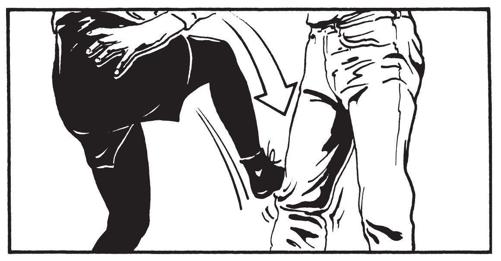SAS Urban Survival Handbook (100 page)
Read SAS Urban Survival Handbook Online
Authors: John Wiseman
Tags: #Health & Fitness, #Reference, #Survival, #Fiction, #Safety, #Self-Help, #Personal & Practical Guides, #General, #Survival Skills

If you are side-on to the attacker, drive the knee hard into the thigh. If you’re lucky you will hit a nerve and deliver a ‘dead leg’—which is very painful.
If your attacker tries to wrestle you to the ground, try to twist so that YOU land on the top. Aim to land so that one or both your knees are driven into their stomach or abdomen.
PRACTISE!
Stand in the on-guard position. Hold your hands out in front of you, side-byside at waist height. Transfer your weight to one foot, immediately snap the other knee up into your hands. DON’T lower your hands. Recover at once into the on-guard position. Now adjust your balance to use the other knee. The action should be fast and recovery immediate. Your knee should smack into the palms of your hands.
Using the leg/foot
Kicking also relies on good balance. Surprise and recovery are vital. You must NOT allow the attacker to grab your foot or leg. If you distract the attacker by spitting, screaming and flailing at the face, the kick will be unexpected.
REMEMBER
Balance is vital when kicking. All the weight is transferred temporarily to the anchor leg. Use your hands/arms partly for balance and partly to distract the attacker by going for the eyes. The hips and waist give a lot of the turning power and thrust to kicks and strikes. PRACTISE!
MULE KICK
From the on-guard position, transfer the weight the opponent’s knee or scraping down the shin, onto one leg, pivoting the hips in that direction. with the side of your foot. Recover immediately Simultaneously raise the other foot, bending to the on-guard position. the leg. Snap the foot out and down, striking

KNIFE DEFENCE
FORCED TO DEAL WITH A KNIFE
Avoid tangling with someone with a knife unless there is absolutely no way to escape. If you are forced to defend yourself:
- ■
Keep circling away from a thrust to the stomach and other vulnerable areas. Suck your stomach in. - ■
Most knife attacks involve diagonal slashes across face or torso. Keep circling to get out of slashing range. - ■
If you get into a tangle with your assailant, you’re too close. If you MUST grab something, grab the attacker’s wrists with both hands. - ■
Better still, use mule kick or knee-to-groin to drive the attacker back out of range. - ■
Wrap a heavy article of clothing around your hand and forearm to deflect the knife blade. - ■
Let the knife impact on a bag or briefcase. - ■
Parry the thrust with an umbrella, walking stick or any stout stick (which gives you a longer reach). Go for joints, bones, collarbone, knees, wrists. - ■
Don’t swing a stick. NEVER pull back before you swing—you have just told the attacker what you are about to do. - ■
Jab with the end of a stick. - ■
Throw dirt in the attacker’s face. - ■
Keep shouting for help.

WARNING
Knives are deadly and can inflict serious injuries or kill. Most people freeze when confronted by any weapon – especially anything as serious as a knife or gun. Avoid confrontations with weapons at all costs. If the weapon is being used as a threat to demand money or goods – hand over whatever is requested and try to get away. If you are not trained in self-defence, you cannot hope to deal with an armed assailant. Which is more important – your property or your life? The only real defence against a weapon is a more powerful weapon. A large heavy stick might give you the advantage against a knife – but not against a gun.
FIREARM DEFENCE
There is very little defence against an attacker armed with a gun or rifle. Some petty thieves rely on the mere sight of a weapon to be sufficient to persuade you to do as they wish. They may not even know how to use a gun. Others may be very proficient and very keen to shoot. You cannot judge whether the gun will be used by accident, in a panic or with cool precision.
Techniques for disarming or grappling with an assailant who is armed with a firearm require a lot of luck, skill and careful timing. Even if you had a lifetime’s training in self-defence, you could not be sure of wrestling a gun or rifle from an attacker’s grasp.
KEEPING YOUR DISTANCE
The distance between you and your attacker plays a vital part in any confrontation. The distance the attacker needs to punch, kick or use a knife may influence your choice of defence technique. If in doubt – let fly with everything you have.
- ■
Punching/striking. The attacker is well within range of kicks. - ■
Knife attack. You should still be able to kick. - ■
Grappling/strangles. Use palm strikes, claw the face, try mule kicks and head butts, use the knees. - ■
Stick attack. Back off or step inside swing, block at the attacker’s wrist with your forearms and use your hands/knees as well as you can. - ■
Firearm attack. Put 50 metres (55 yards) between yourself and the gun – the attacker may be a poor shot. Keep low and don’t run in a straight line. Aim to put an obstruction in the firing line – a fence, trees, cars.
ANIMAL ATTACK
 In the urban environment, it’s not only other people that give cause for fear – animal attack is a very real possibility, both from domestic pets and urbanized wildlife. Even the humble magpie poses a threat in
In the urban environment, it’s not only other people that give cause for fear – animal attack is a very real possibility, both from domestic pets and urbanized wildlife. Even the humble magpie poses a threat in
countries such as Australia, making vicious attacks on unsuspecting passers-by during the egg-laying season.
Dogs, however, remain the biggest threat to the urban dweller. And whilst domestic pets should be reliable, old dogs can become cantankerous, bitches can get defensive when they’ve recently had a litter, and some breeds are encouraged to be excessively territorial.
Guard dogs and pets which were originally intended as guard or hunting dogs may have an aggressive streak—even the owners may be at risk. Some dogs just don’t like strangers. Even a friendly animal might take exception to rough treatment. The ‘bark’ is quite often worse than the ‘bite’, but you may be forced to be quite ruthless to defend yourself.
ATTACKED BY A DOG
- ■
Avoid eye-to-eye contact with any ′vicious′ animal—especially a dog. - ■
Stand still – speak firmly (as the owner might) using clear commands such as ‘No!’ ‘Stay there’ or ‘Sit!’ - ■
Try using a ‘good boy’ gentle voice to talk to the dog. - ■
If a small dog goes for your ankles – a soft kick may deter it. - ■
If the animal jumps up to bite you, offer a well-padded arm – push your arm to the back of the throat. Don’t pull back. Give the dog a sharp blow on the nose. If you must, go for the eyes. Twist an ear and pull hard. - ■
If running or jogging, stop. Walk away before continuing to run. - ■
If chased by a dog (or other animal) drop an article of clothing or a bag! It may stop to investigate it. - ■
Don’t grab any dog by its tail – it can easily bite you. - ■
You may be able to pick up a small dog by the scruff of its neck—and deposit it safely on the other side of a fence or wall.

Not everyone likes dogs and some people—especially children—may be terrified if a large dog approaches. If you own a dog, keep it under control—DON’T let it jump or snap at strangers. NEVER let a dog run free around the neighbourhood. In most countries YOU are liable for the damage or nuisance it may cause.

WARNING
Rabies (hydrophobia) is still common in many parts of the world, although Britain and Australia have more or less eradicated it. The dog or other animal affected may be wild-eyed and foaming at the mouth – but it may not. If you get a large amount of saliva on the skin – or the skin is broken – seek medical attention immediately. It would help if you could identify the animal (see colour pages) as rabies is a horrific and often fatal illness which affects the brain. If bitten, anti-tetanus injections may also be required.
DOG DETERRENTS
There are whistles and electronic devices which are sold, claiming to deter dogs. Dogs have much more sensitive hearing than man – and can hear high frequencies which are beyond our detection. There have always been ‘dog whistles’ but more recent ‘ultrasonic’ battery-operated devices claim to stop dogs in their tracks. In some cases they do work, although real guard dogs are trained to ignore the sound. These deterrents could be worth investigating.